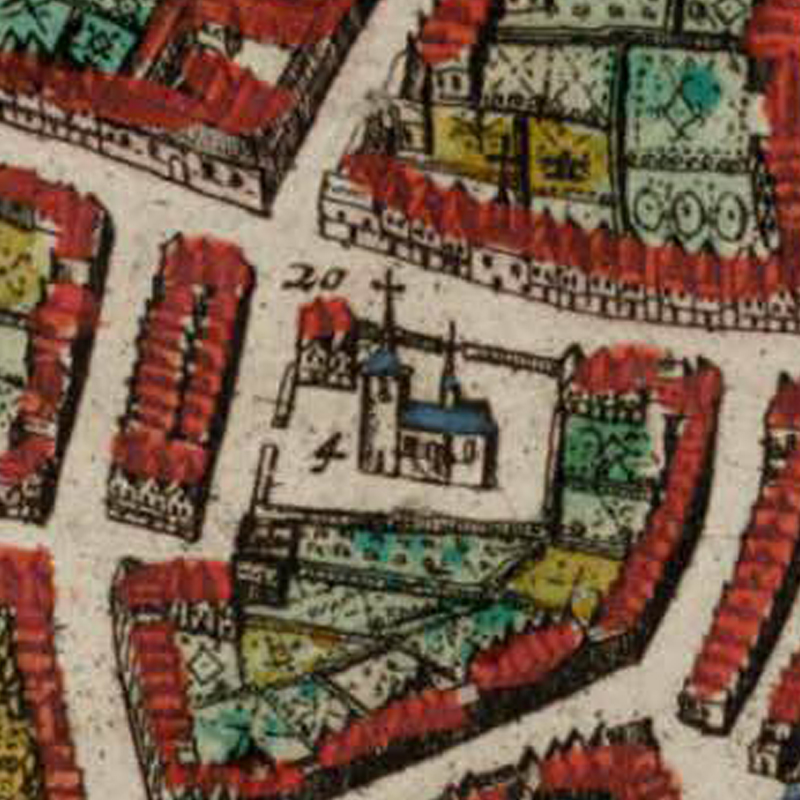ABOUT
The Sint-Jacobskerk (St James’ Church) was formally located 300 metres outside the first city walls, from the closest city gate of Biestpoort (current-day SPAR supermarket and Sole d’Italia on the Brusselsestraat). It was one of the original five medieval parish churches of Leuven, located in the west of the city.
Origin
12th century chapel of the Ter Biest village
It is likely that the church began as a 12th century chapel in the village Ter Biest outside Leuven. It was first recorded in 1187, then in 1252, together with Sint-Kwintens, Sint-Michiels and Sint-Geertrui churches split from the Sint-Pieters parish church, as the city grew in size.
Built in the 13th century, the west tower, which is the oldest part of the church, likely dates between 1220 and 1235.
The church grew in size from the 15th century onwards. There are in total 18 altars, and contains an incredible amount of neo-gothic sculptures and wood work.
What's so special about this place?
A Pilgrim Stop
Besides being a parish church, Sint-Jacobs was a stop in Leuven for pilgrims going to Santiago de Compostella. This is because Leuven is a stop on the route from Cologne, Maastricht and Brussels to Paris. In the 13th century, a pilgrim’s guesthouse called Sint-Laurentiusgasthuis was set up where the Brusselsestraat, Goudbloemstraat and Ridderstraat meet, today where the Exotic World supermarket is located.
The church contained (or still contains) in a ‘Tower of Holy Sacrament‘ – one of the few in Belgium – the Sacrament of Miracles. The Sacrament of Miracles is a “miraculous communion” that was obtained by the Augustinian monks in 1380 in Leuven. After the French Revolution in 1803, it was transferred to Sint-Jacobs.
Why Sint-Jacobskerk is one of the Seven Wonders of Leuven
Also, the Sint-Jacobskerk is one of the Seven Wonders of Leuven. Its famous “Duivelsklokje” (Devil’s Bell) hangs outside its old 13th-century bell-tower – thus earning its the strange fame of being “a church whose bell hangs outside“.
Burial Dump of the Plague
Incidentally, the huge carpark you see by the church, was a huge burial dump for victims of the plague in the 16th century.
Current situation
Closure due to structural instability
Since 1963, the church was closed due to stability issues of the ground.
No definitive solution has been found, although poles have been inserted as deep as 14 metres into the ground to prevent the church from further sinking. It would be a huge loss to Belgian heritage, not just Leuven, should Sint-Jacobskerk collapse as it was a huge historical landmark that contains priceless artistic and cultural artifacts.
Latest update: As recent as 2021, the grounds have finally been stabilised. The interior of the church has now been stripped for a complete renovation of the internal structures.
There is a mistake made in the rumour about the Sint-Jacobskerk’s soft ground. Former Mayor Louis Tobback claimed that in the Middle Ages, the church was called “biest” because the ground was soft and resembles “rotten whey”. But actually Biest was the name of the village and most likely linked to the Frankish word for “plain, place, square” also called “biest”.
HOW IT LOOKS LIKE TODAY
Click on the zoom icon to view the full size.

















De Velder Anne
Mijn overgrootouders hadden hun diamanten huwelijk als één van de laatsten voordat de kerk gesloten werd